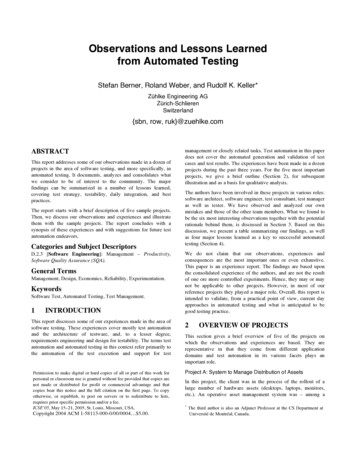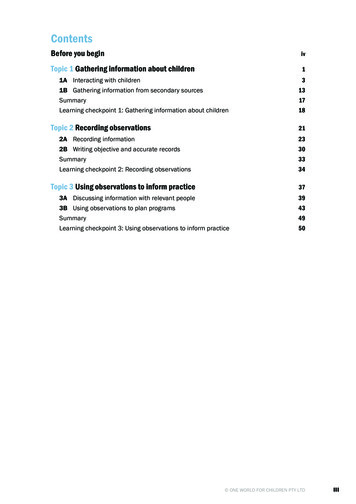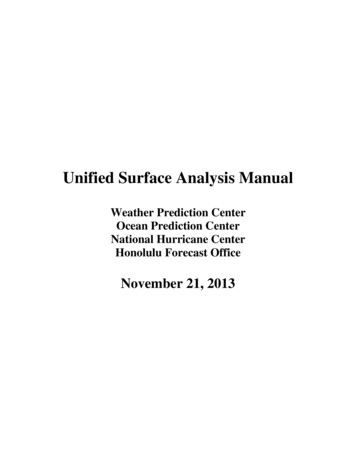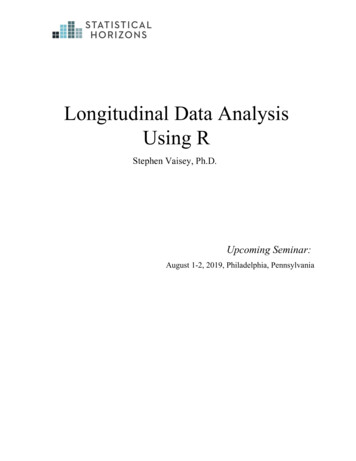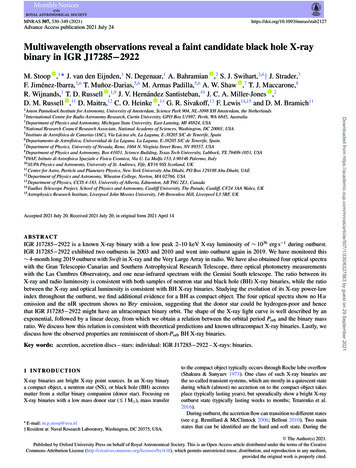
Transcription
MNRAS 507, 330–349 e Access publication 2021 July 24Multiwavelength observations reveal a faint candidate black hole X-raybinary in IGR J17285 2922M. Stoop ,1‹ J. van den Eijnden,1 N. Degenaar,1 A. Bahramian ,2 S. J. Swihart,3,4 † J. Strader,3F. Jiménez-Ibarra,5,6 T. Muñoz-Darias,5,6 M. Armas Padilla,5,6 A. W. Shaw ,7 T. J. Maccarone,8R. Wijnands,1 T. D. Russell ,1,9 J. V. Hernández Santisteban,10 J. C. A. Miller-Jones ,2D. M. Russell ,11 D. Maitra,12 C. O. Heinke ,13 G. R. Sivakoff,13 F. Lewis14,15 and D. M. Bramich111 AntonAccepted 2021 July 20. Received 2021 July 20; in original form 2021 April 14ABSTRACTIGR J17285 2922 is a known X-ray binary with a low peak 2–10 keV X-ray luminosity of 1036 erg s 1 during outburst.IGR J17285 2922 exhibited two outbursts in 2003 and 2010 and went into outburst again in 2019. We have monitored this 4-month long 2019 outburst with Swift in X-ray and the Very Large Array in radio. We have also obtained four optical spectrawith the Gran Telescopio Canarias and Southern Astrophysical Research Telescope, three optical photometry measurementswith the Las Cumbres Observatory, and one near-infrared spectrum with the Gemini South telescope. The ratio between itsX-ray and radio luminosity is consistent with both samples of neutron star and black hole (BH) X-ray binaries, while the ratiobetween the X-ray and optical luminosity is consistent with BH X-ray binaries. Studying the evolution of its X-ray power-lawindex throughout the outburst, we find additional evidence for a BH as compact object. The four optical spectra show no H αemission and the nIR spectrum shows no Brγ emission, suggesting that the donor star could be hydrogen-poor and hencethat IGR J17285 2922 might have an ultracompact binary orbit. The shape of the X-ray light curve is well described by anexponential, followed by a linear decay, from which we obtain a relation between the orbital period Porb and the binary massratio. We discuss how this relation is consistent with theoretical predictions and known ultracompact X-ray binaries. Lastly, wediscuss how the observed properties are reminiscent of short-Porb BH X-ray binaries.Key words: accretion, accretion discs – stars: individual: IGR J17285 2922 – X-rays: binaries.1 I N T RO D U C T I O NX-ray binaries are bright X-ray point sources. In an X-ray binarya compact object, a neutron star (NS), or black hole (BH) accretesmatter from a stellar binary companion (donor star). Focusing onX-ray binaries with a low mass donor star (࣠ 1 M ), mass transfer E-mail: m.p.stoop@uva.nl† Resident at: Naval Research Laboratory, Washington, DC 20375, USA.to the compact object typically occurs through Roche lobe overflow(Shakura & Sunyaev 1973). One class of such X-ray binaries arethe so-called transient systems, which are mostly in a quiescent stateduring which (almost) no accretion on to the compact object takesplace (typically lasting years), but sporadically show a bright X-rayoutburst state (typically lasting weeks to months; Tetarenko et al.2016).During outburst, the accretion flow can transition to different states(see e.g. Remillard & McClintock 2006; Belloni 2010). Two mainstates that can be identified are the hard and soft state. During the C The Author(s) 2021.Published by Oxford University Press on behalf of Royal Astronomical Society. This is an Open Access article distributed under the terms of the CreativeCommons Attribution License (http://creativecommons.org/licenses/by/4.0/), which permits unrestricted reuse, distribution, and reproduction in any medium,provided the original work is properly cited.Downloaded from 327563 by guest on 29 September 2021Pannekoek Institute for Astronomy, University of Amsterdam, Science Park 904, NL-1098 XH Amsterdam, the NetherlandsCentre for Radio Astronomy Research, Curtin University, GPO Box U1987, Perth, WA 6845, Australia3 Department of Physics and Astronomy, Michigan State University, East Lansing, MI 48824, USA4 National Research Council Research Associate, National Academy of Sciences, Washington, DC 20001, USA5 Instituto de Astrofı́sica de Canarias (IAC), Vı́a Láctea s/n, La Laguna, E-38205 S/C de Tenerife, Spain6 Departamento de Astrofı́sica, Universidad de La Laguna, La Laguna, E-38205 S/C de Tenerife, Spain7 Department of Physics, University of Nevada, Reno, 1664 N. Virginia Street Reno, NV 89557, USA8 Department of Physics and Astronomy, Box 41051, Science Building, Texas Tech University, Lubbock, TX 79409-1051, USA9 INAF, Istituto di Astrofisica Spaziale e Fisica Cosmica, Via U. La Malfa 153, I-90146 Palermo, Italy10 SUPA Physics and Astronomy, University of St. Andrews, Fife, KY16 9SS Scotland, UK11 Center for Astro, Particle and Planetary Physics, New York University Abu Dhabi, PO Box 129188 Abu Dhabi, UAE12 Department of Physics and Astronomy, Wheaton College, Norton, MA 02766, USA13 Department of Physics, CCIS 4-183, University of Alberta, Edmonton, AB T6G 2E1, Canada14 Faulkes Telescope Project, School of Physics and Astronomy, Cardiff University, The Parade, Cardiff, CF24 3AA Wales, UK15 Astrophysics Research Institute, Liverpool John Moores University, 146 Brownlow Hill, Liverpool L3 5RF, UK2 International
IGR J17285 2922, a faint candidate black hole(mostly) of NS accretors; BH UCXBs may have been identified inthe extragalactic globular cluster NGC 4472 (Maccarone et al. 2007;Zepf et al. 2008; Steele et al. 2014) and a Galactic BH UCXBmay have been identified in 47 Tuc X9 (Miller-Jones et al. 2015;Bahramian et al. 2017).The third hypothesis is that of symbiotic X-ray binaries. In thisscenario, the compact object accretes matter from the wind of a giantdonor star (see e.g. Masetti et al. 2006, 2007; Mattana et al. 2006).Due to the low mass transfer rate from the giant donor star to thecompact object, the system can be faint in the X-ray band. Recently,it was suggested that symbiotic X-ray binaries may contribute asignificant fraction to the total population of VFXBs (Shaw et al.2020; Bahramian et al. 2021).Several other explanations have been put forward. VFXBs could beseen edge-on, making them appear fainter at such a high inclination.This can (possibly) be seen in systems such as CXOGC J174540.0–290031 (Muno et al. 2005; Porquet et al. 2005) and Swift J1357.2–0933 (Corral-Santana et al. 2013; Mata Sánchez et al. 2015). VFXBscould arise from the so-called period gap X-ray binaries, in which thecompact object captures the wind from a detached M dwarf donor star(Maccarone & Patruno 2013; Heinke et al. 2015). VFXBs could alsosimply be intrinsically bright systems at large distances (Wijnandset al. 2006). A single explanation for the nature of all VFXBs isunlikely, the class of VFXBs is likely to be heterogeneous.VFXBs are interesting for multiple reasons. First, VFXBs allowan in-depth study of low-level accretion and this has revealed adiagnostic that could allow us to distinguish between NS and BHX-ray binaries (Wijnands et al. 2015). Accompanying this with asimultaneous study of the jet can give insight into the couplingbetween the accretion flow and jet at relatively low accretion rates.Secondly, VFXBs are also important for understanding binary evolution and population synthesis (see e.g. Maccarone et al. 2015). Acomplete understanding of the evolution of mass-transferring binarysystems has proved to be difficult to develop (see e.g. Paczyński 1971;Tauris & van den Heuvel 2006). Measuring properties such as Porb ,the masses of the individual binary components and the nature of theaccreting compact object for VFXBs can improve our understandingof their binary evolution and how these systems can get so faint inthe X-ray band. Finally, VFXBs with an ultracompact binary orbitare thought to produce low-frequency gravitational waves. They areconsequently interesting targets to study with future gravitationalwave missions, such as the Laser Interferometer Space Antenna(Nelemans, Yungelson & Portegies Zwart 2001; Nelemans & Jonker2010).1.1 IGR J17285 2922IGR J17285 2922 is a borderline faint to very-faint X-ray binaryfirst detected in outburst by International Gamma-Ray AstrophysicsLaboratory (INTEGRAL) in 2003, with a 20–150 keV X-ray luminosity of LX 1036 erg s 1 for an assumed distance of 8 kpcdue to the proximity to the Galactic Centre (Walter et al. 2004;Barlow et al. 2005). X-ray activity coinciding with the position ofIGR J17285 2922 was detected with the Rossi X-ray Timing Explorer from an unidentified source named XTE J1728 295 in 2010(Markwardt & Swank 2010). XTE J1728 295 was confirmed to bethe same source as IGR J17285 2922 in subsequent observationswith the Neil Gehrels Swift Observatory (Swift; Gehrels et al. 2004)and INTEGRAL (Turler et al. 2010; Yang et al. 2010). The searchfor the optical counterpart during this 2010 outburst resulted in theidentification of a variable star with R 19 mag and I 18.5 mag(Russell et al. 2010a, b; Torres et al. 2010). An in-depth investigationMNRAS 507, 330–349 (2021)Downloaded from 327563 by guest on 29 September 2021soft state, the X-ray spectrum is dominated by low energy emission,while during the hard state the emission is dominated by high energyemission. In the hard state, the X-ray binary can launch part of theaccreted material in the form of a collimated jet (Spencer 1979;Fender 2006). While the accretion flow is most prominently detectedin the X-ray band up to optical, the jet is detected in radio andpossibly also in (near-)infrared and optical (Russell et al. 2006;Russell, Fender & Jonker 2007). The matter in the jet is thoughtto arise from, and thus be correlated to, the accretion flow. Forexample, the study of X-ray binaries in the hard state in radio andX-ray simultaneously has revealed a coupling between this in- andoutflow (see e.g. Corbel et al. 2003, 2013; Gallo et al. 2014; Gallo,Degenaar & van den Eijnden 2018).The outburst-quiescence accretion cycles in transient X-ray binaries can be described by a disc instability model. As matter fromthe donor star builds up in the accretion disc during quiescence, athermal instability eventually leads to an outburst with an increasedmass accretion rate on to the compact object (see e.g. Lasota2001; Hameury 2019). Transient X-ray binaries can be looselyclassified based on the 2–10 keV peak X-ray luminosity duringoutburst (Wijnands et al. 2006). The ‘bright X-ray binaries’ reachpeak luminosities of 1038 –1039 erg s 1 . However, not all X-raybinaries are this bright. Systems that have a peak luminosity of 1036 –1037 erg s 1 are typically called ‘faint X-ray binaries’. Other X-raybinaries are even fainter, with peak luminosities of 1034 –1036 erg s 1 ,which are called ‘very faint X-ray binaries’ (VFXBs). This faintnessmakes VFXBs hard to detect, with outbursts that may go unnoticed by X-ray all-sky monitors given their typically low resultingfluxes.Three promising explanations have been proposed to account forthe faint nature of these VFXBs. The first hypothesis is that VFXBsharbour NSs that truncate the accretion disc with their relativelystrong magnetic field (Illarionov & Sunyaev 1975; Heinke et al.2015). This prevents efficient accretion on to the NS, making thesystem faint in the X-ray band. It could also be possible for suchsystems to display a propeller driven outflow (D’Angelo & Spruit2010). To identify a truncation of the inner disc, X-ray reflectionspectroscopy can be used to measure the inner disc radius (Fabianet al. 1989). Although there are indications of a truncated disc insome VFXBs, distinguishing a magnetically truncated disc from theformation of a radiatively inefficient accretion flow in the disc hasproved difficult (Narayan & Yi 1994; Degenaar et al. 2017; van denEijnden et al. 2018).The second hypothesis is that of ultracompact X-ray binaries(UCXBs; King & Wijnands 2006; Heinke et al. 2015). The orbitalperiod (Porb ) of such systems is typically defined as ࣠ 90 min(Nelson, Rappaport & Joss 1986), which requires the donor star to behydrogen poor to still fit within its Roche lobe. Ultracompact X-raybinaries can have significantly reduced mass transfer rates, makingthe system faint in the X-ray band. A UCXB can be identified bydirectly measuring Porb (e.g. measuring periodic eclipses or dips inX-ray or optical, or measuring periodic orbital modulations fromoptical photometry), indirectly using the requirement of a smallaccretion disc (e.g. using the ratio of optical to X-ray flux), or otherdiagnostics such as estimating the composition of the donor throughspectral data [for a list of methods see e.g. in’t Zand, Jonker &Markwardt (2007)]. One of these diagnostics involves the absence ofH α in optical spectra, as this may indicate a hydrogen-poor disc andtherefore a hydrogen-poor donor star (Nelemans et al. 2004; Werneret al. 2006; Hernández Santisteban et al. 2019). Several UCXBs havebeen confirmed so far (e.g. Cartwright et al. 2013; Koliopanos et al.2021, and references therein). The known sample of UCXBs consists331
332M. Stoop et al.2 O B S E RVAT I O N S A N D A N A LY S I S2.1 X-raysWe monitored the outburst of IGR J17285 2922 with Swift to trackthe outburst evolution and the accretion state. Between April 10 (2 dafter the initial INTEGRAL detection) and 2019 September 20, a totalof 45 observations were taken (Target ID 00011287 and 00011303,see Table 1 for an overview) with the Swift X-ray Telescope (XRT;Burrows et al. 2005). These Swift/XRT observations had a typicalduration of 1 ks. Only the first observation was taken in WindowTiming (WT) mode, while all other observations were taken inPhoton Counting (PC) mode. We extracted the 0.3–10 keV countrates with the Swift/XRT product generator1 (Evans et al. 2007,2009). We calibrated the observations using the XRTPIPELINE (version0.13.5) and the CALDB in the HEASOFT package (version 6.26.1)provided by HEASARC.2 The images and spectra were extracted usingXSELECT (version v2.4g). For the single WT observation (ObsID00011287001), we used a circular source extraction region with aradius of 35 arcsec and two circular background extraction regionswith radii of 35 arcsec each, placed sufficiently far away fromthe source. For the PC observations, we first correct for pile-upif needed. For the 2nd up to and including the 8th observations(ObsID 00011303002–00011303010), correction for pile-up wasrequired and we used an annular source extraction region withan inner radius of 10 arcsec and outer radius of 35 arcsec. Forthe 9th, 10th, 11th, and 13th observation (ObsID 00011303011–00011303013 and 00011303015), correction for pile-up was alsorequired and we used an annular source extraction region withan inner radius of 6 arcsec and outer radius of 35 arcsec. Forall other PC observations, we used a circular source extractionregion with a radius of 25 arcsec. In all the PC observations,we used three circular background extraction regions with radiiof 60 arcsec each. The ancillary response files were created withthe observation-specific exposure-maps using XRTMKARF (version0.6.3). The response matrix files swxwt0to2s6 20131212v015and swxpc0to12s6 20130101v014, for WT and PC mode,1 https://www.swift.ac.uk/userrespectively, were obtained from the CALDB (version 20190412).All spectra were grouped to have a minimum of 1 count per bin withGRPPHA. On top of this we also grouped the first five spectra (ObsIDs00011287001 and 00011303002–00011303005) separately to havea minimum of 20 counts per bin with GRPPHA.We fitted the Swift/XRT spectra using XSPEC (v. 12.10.1f; Arnaud1996). We used an absorbed power-law model (TBABS POWERLAW)and a combined absorbed power law plus blackbody model (TBABS [BBODYRAD POWERLAW]). We performed these fits with thehydrogen column density parameter (NH in TBABS; Wilms et al.2000) as three different options; NH as a free parameter, fixed at NH 0.679 1022 cm 2 (see Section 4.5), and fixed at NH 0.99 1022cm 2 (determined by the simultaneous fit of all Swift/XRT spectrawith NH tied for each spectrum). The impact of NH on the determinedspectral parameters is discussed in Section 4.5. We adopted the crosssections by Verner et al. (1996) and abundances by Wilms et al.(2000). For consistency, and due to the low total counts in the lasthalf of the outburst, the model fitting was done using Cash statistics(Cash 1979) in all spectra. In addition, we also used χ 2 statisticsfor the first five spectra to perform the F-test (see Section 3.3). Theresults using both Cash and χ 2 statistics were consistent with eachother.We determined the 0.5–10 and 1–10 keV unabsorbed fluxes withCFLUX. For radio epochs 1, 3, and 4 (see Section 2.2), no quasisimultaneous Swift/XRT observations were taken. We determinedthe X-ray flux (1–10 keV) during these radio epochs using a linearinterpolation between the closest Swift/XRT observations before andafter each of these radio epochs. The two fluxes used for eachinterpolation are similar down to 30 per cent. We use the largestpositive and negative 1 σ error of the interpolated X-ray fluxes forthe 1–10 keV flux during each radio epoch. The 1–10 keV X-rayfluxes adopted during each radio epoch are listed in Table 2.2.2 RadioWe monitored the 2019 outburst of IGR J17285 2922 with theVLA over 7 epochs (project code SF8027, see Table 2 for anoverview). In epochs 1 to 4, the VLA observations were taken inthe B configuration, in epochs 5 and 6 in a BnA configuration, andin epoch 7 in the A configuration. In all epochs, IGR J17285 2922was observed at C band in 8-bit mode, with two subbands at centralfrequencies of 4.5 and 7.5 GHz, with 1 GHz bandwidth each. Theprimary flux calibrator was 3C 286 J1331 3030 and the secondaryphase calibrator was J1743 3058 ( 3.6 angular distance).We analysed the observations using the Common AstronomySoftware Application3 (CASA version 5.6.1; McMullin et al. 2007).Radio frequency interference and other data artefacts were removedby careful visual inspection, in combination with automated CASAroutines. We imaged the calibrated 4–5 and 7–8 GHz Stokes I dataseparately using TCLEAN, with a Briggs weighting scheme robustparameter of 0, balancing sensitivity and the impact of other nearbysources. We determined the flux density in the image plane by fittinga 2D elliptical Gaussian using IMFIT, with the ellipse parameters fixedto those of the synthesized beam. We determined the 1 σ error onthe flux density by measuring the RMS of a nearby area containingno sources in the image plane. When the source was not detected ineither the 4–5 or 7–8 GHz subband, we determined a 3 σ upper limitas three times the RMS over the source location in the image plane.The details of the VLA observations are given in Table 2.objects/2 https://heasarc.gsfc.nasa.gov/MNRAS 507, 330–349 (2021)3 https://casa.nrao.edu/Downloaded from 327563 by guest on 29 September 2021on this 2010 outburst was done by Sidoli et al. (2011) using ahigh quality XMM–Newton observation, along with INTEGRAL data.Sidoli et al. (2011) concluded that IGR J17285 2922 is a transientVFXB, although no definitive answer was found for the nature ofthe compact object. The absence of thermonuclear X-ray bursts andX-ray pulsations allowed for either a NS or BH primary (Sidoli et al.2011).More recently, on 2019 April 8–9, INTEGRAL found renewedX-ray activity from IGR J17285 2922 (Ducci et al. 2019). Tofurther investigate its nature, we monitored this 2019 outburst inthe X-ray band with Swift and in radio with the Karl G. JanskyVery Large Array (VLA). On top of this, we obtained throughoutthe outburst four optical spectra covering H α with the SouthernAstrophysical Research Telescope (SOAR) and Gran TelescopioCanarias (GTC), one near-infrared (nIR) spectrum with the GeminiSouth telescope and three optical photometry measurements withthe Las Cumbres Observatory (LCO) telescope network. We will usethese multiwavelength observations to constrain the nature of thecompact object, donor star, as well as the binary orbital properties ofthe (V)FXB IGR J17285 2922.
IGR J17285 2922, a faint candidate black hole333Table 1. Overview of the Swift/XRT observations and spectral fits for the 2019 outburst of IGR J17285 2922. We used an absorbed power-lawmodel with the hydrogen column density fixed at NH 0.99 1022 cm 2 . gives the X-ray power-law index. For the non-detections asIGR J17285 2922 becomes quiescent, we assume that the spectra are equal to the last detected spectrum (ObsID 00011287002) to determinethe 3 σ upper limits on the 0.5–10 keV X-ray flux by scaling the count rates. All uncertainties are 1 σ . Upper limits are 3 σ . Fixed parameters areindicated with an asterisk.ObsIDDateMJDCount rate(cts s 1 ) 0.5–10 keV flux( 10 12 er g cm 2 s 1 )C-stat / dof1230001128700100011303002000113030032019 Apr 102019 Apr 152019 Apr 175858358588585903.2 0.12.7 0.12.6 0.11.69 0.081.61 0.081.63 0.07152 6193 8191 8 7386 / 438270 / 352345 / 3864000113030042019 Apr 19585922.2 0.11.70 0301000011303011000113030122019 Apr 212019 Apr 292019 May 12019 May 32019 May 52019 May 1.16 0.10.070.080.080.060.051.581.471.61.531.501.53 0.080.090.10.090.090.08154 146 110 110 97 94 5 477665327 / 346245 / 306219 / 243216 / 286239 / 276249 / 13030202019 May 92019 May 112019 May 132019 May 152019 May 172019 May 192019 May 232019 May .890.770.640.740.660.59 .351.31.41 0.10.10.090.080.090.090.10.0971 70 66 60 49 55 51 44 3 25643333135 / 189126 / 135209 / 278258 / 308201 / 293245 / 300187 / 239229 / 26919000113030212019 May 27586300.50 0.031.4 0.141 3 1303029000113030302019 May 292019 May 312019 June 22019 June 42019 June 62019 June 82019 June 102019 June 192019 June 50.500.460.500.440.420.460.490.57 42 39 36 41 27 36 36 37 46 3 22222322229000113030312019 July 3586670.33 3030352019 July 102019 July 172019 July 242019 July 036000112870022019 Aug 72019 Aug 128700900011287010000112870112019 Aug 232019 Aug 252019 Aug 272019 Aug 292019 Aug 302019 Sep 12019 Sep 82019 Sep 132019 Sep 20587185872058722587245872558727587345873958746 020.14 0.010.031 0.006 0.02 0.009 0.009 0.007 0.01 0.009 0.007 0.01 0.02To determine the spectral index (α) of the radio emission, weperformed Monte Carlo (MC) simulations. For each radio epochin which IGR J17285 2922 was detected in both the 4–5 and 7–8 GHz subband, we drew 106 frequencies between 4 and 5 GHz(ν 4–5 GHz ) and between 7 and 8 GHz (ν 7–8 GHz ) assuming a uniformdistribution. For each of these individual frequencies, we drew a fluxdensity (S4–5 GHz and S7–8 GHz ) assuming a Gaussian distribution withmean and standard deviation equal to the observed flux density .10.10.090.09282 / 326163 / 250240 / 253167 / 254211 / 234210 / 28778 / 81254 / 252196 / 254228 / 274183 / 2611.3 0.128 3 2125 / 136 0.10.10.30.232 225 216 213 2 1165 / 214137 / 18753 / 6153 / 701.4 0.21.4 0.512 2 0.92.7 0.672 / 7030 / 201.81.51.81.71.4 1.4 1.4 1.4 1.4 1.4 1.4 1.4 1.4 1.6 0.8 0.8 0.6 1.2 0.8 0.6 1.2 2.0–––––––––RMS, respectively. We determined α using S7–8 GHz S4–5 GHz (ν 7–8 GHz / ν 4–5 GHz )α . We determined α and 1 σ errors, as the 50th,16th, and 84th percentile, respectively. When IGR J17285 2922was detected in only one subband, we determined a 3 σ upper limiton α using the procedure described in van den Eijnden et al. (2019).In this procedure, an MC simulation is performed to determine atwhat α (3 σ upper or lower limit) the non-detected subband wouldhave been detected.MNRAS 507, 330–349 (2021)Downloaded from 327563 by guest on 29 September 2021 154 7 6
334M. Stoop et al.Table 2. Overview of the VLA observations for the 2019 outburst of IGR J17285 2922. The spectral index α for each VLA observation is calculated asdescribed in Section 2.2. For each VLA observation, we give the (quasi-)simultaneous 1–10 keV X-ray flux and the Swift/XRT ObsID(s) used for this flux.Swift/XRT ObsID(s) followed by an asterisk indicate that the (quasi-)simultaneous 1–10 keV X-ray flux has been interpolated. Upper and lower limits are 3 σ ,while all uncertainties are 1 σ .DateMJD12019 Apr 135858622019 Apr 1958592Frequency(GHz)Flux density(μJy)Spectral index α1–10 keV X-ray flux( 10 12 er g cm 2 s 1 )Swift/XRT ObsID(s)4–5118 70.1 0.1152 9 800011287001 – 00011303002 7–8126 50.2 0.3129 7 6000113030044–593 107–8102 82019 June 14586484–57–8 3380 9 0.933 200011303028 – 00011303029 42019 June 23586574–57–881 1167 9 0.4 0.437 300011303029 – 00011303030 52019 July 11586754–57–8 3862 10 0.227 20001130303262019 July 30586944–562 12 0.6 0.610 2 1000113030357–846 114–5 33–2.4 0.9 0.7000112870027–8 3072019 Aug 15587102.3 Optical photometryWe observed IGR J17285 2922 with the LCO 2-m Faulkes and1-m network of telescopes during the 2019 outburst, as part of amonitoring campaign of 50 LMXBs (Lewis et al. 2008; Russellet al. 2010a, b). Imaging data were taken mostly in the Bessell I filter.The newly developed ‘X-ray Binary New Early Warning System’(XB-NEWS) pipeline (Russell et al. 2019) was used to computeastrometric solutions, perform multi-aperture photometry, and fluxcalibrate the photometry. The pipeline produces a calibrated lightcurve for the target (for more details see Russell et al. 2019; Goodwinet al. 2020). For images in which the target is not automaticallydetected above the detection threshold by the pipeline, XB-NEWSperforms forced multi-aperture photometry at the known position ofthe source. All derived magnitudes with an uncertainty 0.25 magwere considered unreliable, and were rejected.2.4 Optical spectroscopyWe obtained four epochs of optical spectroscopy ofIGR J17285 2922 during the outburst with the purpose ofinvestigating the presence of H α. We observed the target on thenights of 2019 April 30 – May 1, May 2–3, and June 29–30with SOAR, using the Goodman Spectograph (Clemens, Crain &Anderson 2004). The first two runs both consisted of two exposuresof 1800 s each, using a 400 l/mm grating with a 0.95 arcsec slit,yielding a full width at half-maximum (FWHM) resolution of 5.6 Å over the wavelength range from 3800–7800 Å. The finalrun consisted of two 1500 s exposures, using the same grating ona 1.2 arcsec slit, resulting in a 7.6 Å FWHM resolution between 4850 and 8850 Å. The spectra were reduced and optimallyextracted following standard practices using IRAF.We also observed IGR J17285 2922 using the OSIRIS instrument(Cepa et al. 2000) mounted on the 10.4-m GTC, on the night of 2019July 21–22. We obtained two spectra with exposures times of 600 seach, using the grism R2500R (5575–7685 Å) with a 1 arcsec slit,providing a velocity resolution of 160 km s 1 . The data reduction andMNRAS 507, 330–349 (2021)calibration was performed using IRAF, after which we used MOLLYand PYTHON routines to analyse, normalize, and plot the spectra.2.5 nIR spectroscopyOn 2019 July 8, we obtained long slit spectroscopy of the nIRcounterpart to IGR J17285 2922 with Flamingos-2 on the 8.1mGemini South telescope at Cerro Páchon, Chile as part of programID GS-2019A-FT-106 (PI: Shaw). We obtained 21 120 s exposureswith the HK grism and a slit width of 2 pixels (0. 36) which provides atypical FWHM resolution of 24 Å at Brackett γ (Brγ ; 2.166 μm).To reduce the effect of the rapidly changing background at nIRwavelengths we dithered along the spatial directions of the slit inan ABBA pattern. On the same night we also used the same set upto observe the telluric standard star Hip 82714, obtaining 4 2 simages.Data were reduced using the Gemini package in IRAF4 followingstandard procedures. We normalized the averaged spectrum of thetelluric standard star and removed the hydrogen Brackett-seriesabsorption features by subtracting a best-fitting Voigt profile. Wethen used the task nstelluric to shift and scale the science andtelluric spectra in order to optimally divide out telluric features fromthe science spectra.3 R E S U LT S3.1 X-ray and radio light curvesWe show the Swift and VLA light curve of the 2019 outburst ofIGR J17285 2922 in Fig. 1. The Swift light curve shows a globallydecreasing count rate as the outburst proceeds, with a plateau between2019 June 6 and July 6 (MJD 58640 and 58670, respectively).IGR J17285 2922 was first observed with Swift on 2019 April 104 e/gemini-iraf-generalDownloaded from 327563 by guest on 29 September 20213
IGR J17285 2922, a faint candidate black hole335(MJD 58583), and was last detected on 2019 August 16 (MJD 58711),for a total outburst duration of 128 d as observed with Swift. The42nd Swift/XRT observation (MJD 58734) is reported as a detectionby the Swift/XRT product generator (Evans et al. 2007, 2009), butmanually analysing this observation with XIMAGE, with both DETECTand SOSTA, shows that IGR J17285 2922 is not detected at even 1 σconfidence. Instead, we adopt a 3 σ upper
IGR J17285 2922 is a known X-ray binary with a low peak 2-10 keV X-ray luminosity of 1036 ergs 1 during outburst. IGR J17285 2922 exhibited two outbursts in 2003 and 2010 and went into outburst again in 2019. We have monitored this 4-month long 2019 outburst with Swift in X-ray and the Very Large Array in radio. We have also .


